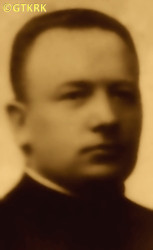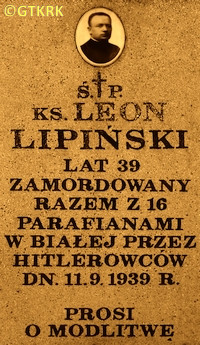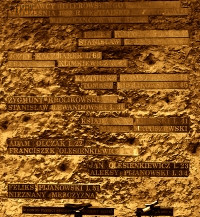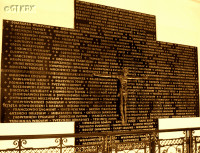Roman Catholic
St Sigismund parish
05-507 Słomczyn
85 Wiślana Str.
Konstancin deanery
Warsaw archdiocese, Poland
full list:
displayClick to display full list

searchClick to search full list by categories
wyświetlKliknij by wyświetlić pełną listę po polsku

szukajKliknij by przeszukać listę wg kategorii po polsku

Martyrology of the clergy — Poland
XX century (1914 – 1989)
personal data
surname
LIPIŃSKI
forename(s)
Leo (pl. Leon)
function
diocesan priest
creed
Latin (Roman Catholic) Church RCmore on
en.wikipedia.org
[access: 2014.09.21]
diocese / province
Łódź diocesemore on
en.wikipedia.org
[access: 2013.05.19]
date and place
of death
11.09.1939

Białatoday: Zgierz gm., Zgierz pov., Łódź voiv., Poland
more on
en.wikipedia.org
[access: 2022.02.14]
details of death
In 1919, at the beginning of the Polish–Russian war of 1919‐1921, drafted into the Polish Army. Discharged after the end of the war in 1921.
After German invasion of Poland on 01.09.1939 (Russians invaded Poland 17 days later) and start of the World War II murdered by German soldiers during the battle on the river Bzura on 09‐22.09.1939, the largest armed battle of the 09.1939 campaign.
After capturing the Biała village Germans rounded of all inhabitants of Kościelna Str. and marched them to the village square.
There selected 16 men, among them the parish priest, locked them in a house — the women were herded into a roadside ditch and told to sit there quietly.
Then pelted the house with grenades.
Wounded, fell on one of the men, covering him in blood and thus saving his life.
The wounded were finished off with pistol shots.
The Germans threw the bodies into a pit dug on the property behind the barn — the bodies were dragged there with hooks.
cause of death
mass murder
perpetrators
Germans
sites and events
Ribbentrop‐MolotovClick to display the description, Pius XI's encyclicalsClick to display the description, Polish‐Russian war of 1919‐1921Click to display the description
date and place
of birth
19.01.1897

Stare Rokicietoday: part of Rokicie district in Łódź, Łódź city pov., Łódź voiv., Poland
more on
en.wikipedia.org
[access: 2021.07.18]
parents
LIPIŃSKI Stanislav
🞲 ?, ? — 🕆 ?, ?

SOLAREK Victoria
🞲 ?, ? — 🕆 ?, ?
baptism
19.01.1897

Łódźtoday: Łódź city pov., Łódź voiv., Poland
more on
en.wikipedia.org
[access: 2021.07.18]
Exaltation of the Holy Cross RC church
presbyter (holy orders)
ordination
25.12.1926

Łódźtoday: Łódź city pov., Łódź voiv., Poland
more on
en.wikipedia.org
[access: 2021.07.18]
St Stanislav Kostka the Confessor RC cathedral churchmore on
en.wikipedia.org
[access: 2025.03.14]
positions held
1937 – 1939
parish priest — Białatoday: Zgierz gm., Zgierz pov., Łódź voiv., Poland
more on
en.wikipedia.org
[access: 2022.02.14] ⋄ St Peter and St Paul the Apostles RC parish ⋄ Zgierztoday: Zgierz urban gm., Zgierz pov., Łódź voiv., Poland
more on
en.wikipedia.org
[access: 2021.12.18] RC deanery
1932 – 1937
parish priest — Stróżatoday: Rząśnia gm., Pajęczno pov., Łódź voiv., Poland
more on
en.wikipedia.org
[access: 2022.01.28] ⋄ St Casimir and St Joseph Spouse of the Blessed Virgin Mary RC parish ⋄ Bełchatówtoday: Bełchatów urban gm., Bełchatów pov., Łódź voiv., Poland
more on
en.wikipedia.org
[access: 2021.12.18] RC deanery
1931 – 1932
administrator — Retkiniatoday: district of Łódź, Łódź city pov., Łódź voiv., Poland
more on
en.wikipedia.org
[access: 2021.12.18] ⋄ Sacred Heart of Jesus RC parish ⋄ Konstantynów Łódzkitoday: Konstantynów Łódzki urban gm., Pabianice pov., Łódź voiv., Poland
more on
en.wikipedia.org
[access: 2021.12.19] RC deanery — acting („ad interim”)
1931
vicar — Tuszyntoday: Tuszyn gm., Łódź‐east pov., Łódź voiv., Poland
more on
en.wikipedia.org
[access: 2021.12.18] ⋄ St Vitalis the Martyr RC parish ⋄ Tuszyntoday: Tuszyn gm., Łódź‐east pov., Łódź voiv., Poland
more on
en.wikipedia.org
[access: 2021.12.18] RC deanery
1929 – 1931
vicar — Piotrków Trybunalskitoday: Piotrków Trybunalski city pov., Łódź voiv., Poland
more on
en.wikipedia.org
[access: 2021.07.29] ⋄ Sacred Heart of Jesus RC parish ⋄ Piotrków Trybunalskitoday: Piotrków Trybunalski city pov., Łódź voiv., Poland
more on
en.wikipedia.org
[access: 2021.07.29] RC deanery — also: prefect of elementary schools
1928 – 1929
prefect — Ozorkówtoday: Ozorków urban gm., Zgierz pov., Łódź voiv., Poland
more on
en.wikipedia.org
[access: 2020.11.20] ⋄ St Joseph Spouse of the Blessed Virgin Mary and Exaltation of the Holy Cross RC parish ⋄ Ozorkówtoday: Ozorków urban gm., Zgierz pov., Łódź voiv., Poland
more on
en.wikipedia.org
[access: 2020.11.20] RC deanery — also: chaplain of the Sacred Heart of Jesus chapel of the Gray Ursuline Sisters USJK
1927 – 1928
prefect — Sulejówtoday: Sulejów gm., Piotrków Trybunalski pov., Łódź voiv., Poland
more on
en.wikipedia.org
[access: 2020.11.05] ⋄ St Florian the Martyr RC parish ⋄ Piotrków Trybunalskitoday: Piotrków Trybunalski city pov., Łódź voiv., Poland
more on
en.wikipedia.org
[access: 2021.07.29] RC deanery
1927
prefect — Grabówtoday: Grabów gm., Łęczyca pov., Łódź voiv., Poland
more on
en.wikipedia.org
[access: 2020.11.05] ⋄ St Stanislav the Bishop and Martyr RC parish ⋄ Łęczycatoday: Łęczyca urban gm., Łęczyca pov., Łódź voiv., Poland
more on
en.wikipedia.org
[access: 2021.12.18] RC deanery — Public Primary School, and then secondary schools
1923 – 1926
student — Łódźtoday: Łódź city pov., Łódź voiv., Poland
more on
en.wikipedia.org
[access: 2021.07.18] ⋄ philosophy and theology, Theological Seminary
sites and events
descriptions
Ribbentrop‐Molotov: Genocidal Russian‐German alliance pact between Russian leader Joseph Stalin and German leader Adolf Hitler signed on 23.08.1939 in Moscow by respective foreign ministers, Mr. Vyacheslav Molotov for Russia and Joachim von Ribbentrop for Germany. The pact sanctioned and was the direct cause of joint Russian and German invasion of Poland and the outbreak of the World War II in 09.1939. In a political sense, the pact was an attempt to restore the status quo ante before 1914, with one exception, namely the „commercial” exchange of the so‐called „Kingdom of Poland”, which in 1914 was part of the Russian Empire, fore Eastern Galicia (today's western Ukraine), in 1914 belonging to the Austro‐Hungarian Empire. Galicia, including Lviv, was to be taken over by the Russians, the „Kingdom of Poland” — under the name of the General Governorate — Germany. The resultant „war was one of the greatest calamities and dramas of humanity in history, for two atheistic and anti‐Christian ideologies — national and international socialism — rejected God and His fifth Decalogue commandment: Thou shall not kill!” (Abp Stanislav Gądecki, 01.09.2019). The decisions taken — backed up by the betrayal of the formal allies of Poland, France and Germany, which on 12.09.1939, at a joint conference in Abbeville, decided not to provide aid to attacked Poland and not to take military action against Germany (a clear breach of treaty obligations with Poland) — were on 28.09.1939 slightly altered and made more precise when a treaty on „German‐Russian boundaries and friendship” was agreed by the same murderous signatories. One of its findings was establishment of spheres of influence in Central and Eastern Europe and in consequence IV partition of Poland. In one of its secret annexes agreed, that: „the Signatories will not tolerate on its respective territories any Polish propaganda that affects the territory of the other Side. On their respective territories they will suppress all such propaganda and inform each other of the measures taken to accomplish it”. The agreements resulted in a series of meeting between two genocidal organization representing both sides — German Gestapo and Russian NKVD when coordination of efforts to exterminate Polish intelligentsia and Polish leading classes (in Germany called «Intelligenzaktion», in Russia took the form of Katyń massacres) where discussed. Resulted in deaths of hundreds of thousands of Polish intelligentsia, including thousands of priests presented here, and tens of millions of ordinary people,. The results of this Russian‐German pact lasted till 1989 and are still in evidence even today. (more on: en.wikipedia.orgClick to attempt to display webpage
[access: 2015.09.30])
Pius XI's encyclicals: Facing the creation of two totalitarian systems in Europe, which seemed to compete with each other, though there were more similarities than contradictions between them, Pope Pius XI issued in 03.1937 (within 5 days) two encyclicals. In the „Mit brennender Sorge” (Eng. „With Burning Concern”) published on 14.03.1938, condemned the national socialism prevailing in Germany. The Pope wrote: „Whoever, following the old Germanic‐pre‐Christian beliefs, puts various impersonal fate in the place of a personal God, denies the wisdom of God and Providence […], whoever exalts earthly values: race or nation, or state, or state system, representatives of state power or other fundamental values of human society, […] and makes them the highest standard of all values, including religious ones, and idolizes them, this one […] is far from true faith in God and from a worldview corresponding to such faith”. On 19.03.1937, published „Divini Redemptoris” (Eng. „Divine Redeemer”), in which criticized Russian communism, dialectical materialism and the class struggle theory. The Pope wrote: „Communism deprives man of freedom, and therefore the spiritual basis of all life norms. It deprives the human person of all his dignity and any moral support with which he could resist the onslaught of blind passions […] This is the new gospel that Bolshevik and godless communism preaches as a message of salvation and redemption of humanity”… Pius XI demanded that the established human law be subjected to the natural law of God , recommended the implementation of the ideal of a Christian state and society, and called on Catholics to resist. Two years later, National Socialist Germany and Communist Russia came together and started World War II. (more on: www.vatican.vaClick to attempt to display webpage
[access: 2023.05.28], www.vatican.vaClick to attempt to display webpage
[access: 2023.05.28])
Polish‐Russian war of 1919‐1921: War for independence of Poland and its borders. Poland regained independence in 1918 but had to fight for its borders with former imperial powers, in particular Russia. Russia planned to incite Bolshevik‐like revolutions in the Western Europe and thus invaded Poland. Russian invaders were defeated in 08.1920 in a battle called Warsaw battle („Vistula river miracle”, one of the 10 most important battles in history, according to some historians). Thanks to this victory Poland recaptured part of the lands lost during partitions of Poland in XVIII century, and Europe was saved from the genocidal Communism. (more on: en.wikipedia.orgClick to attempt to display webpage
[access: 2014.12.20])
sources
personal:
archidiecezja.lodz.plClick to attempt to display webpage
[access: 2021.12.19], dziwoszbogdan.republika.plClick to attempt to display webpage
[access: 2012.12.28], lodz-andrzejow.plClick to attempt to display webpage
[access: 2024.06.16], metryki.genealodzy.plClick to attempt to display webpage
[access: 2025.03.15], cybra.lodz.plClick to attempt to display webpage
[access: 2015.04.18]
original images:
lodz-andrzejow.plClick to attempt to display webpage
[access: 2024.06.16], lodz-andrzejow.plClick to attempt to display webpage
[access: 2024.06.16], panaszonik.blogspot.comClick to attempt to display webpage
[access: 2015.09.30], www.katedra.lodz.plClick to attempt to display webpage
[access: 2014.01.06]
LETTER to CUSTODIAN/ADMINISTRATOR
If you have an Email client on your communicator/computer — such as Mozilla Thunderbird, Windows Mail or Microsoft Outlook, described at WikipediaPatrz:
en.wikipedia.org, among others — try the link below, please:
LETTER to CUSTODIAN/ADMINISTRATORClick and try to call your own Email client
If however you do not run such a client or the above link is not active please send an email to the Custodian/Administrator using your account — in your customary email/correspondence engine — at the following address:

giving the following as the subject:
MARTYROLOGY: LIPIŃSKI Leo
To return to the biography press below:
 Click to return to biography
Click to return to biography











